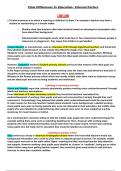Summary
Summary Class Differences In Education - Internal Factors
- Course
- Institution
This document delves into the sociological factors influencing educational outcomes among different social classes, focusing on internal school dynamics. It covers key theories and concepts such as labelling, self-fulfilling prophecy, streaming, and the creation of pupil subcultures. Detail...
[Show more]



